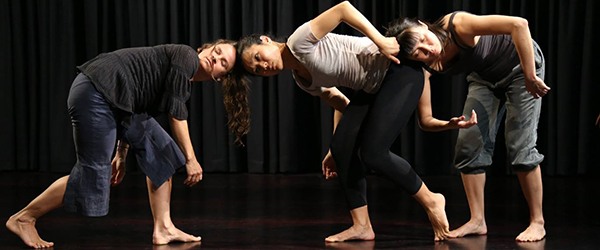Home | Blog | Improlab
Improlab
Image by Vsevelod Vlaskine
A week ago I trekked to Sydney University Rex Cramphorn studio, the new location for Tess de Quincey’s Improlab events for 2015, after nearly 10 years at Critical Path.
It was very hot, like this weekend past, and I was contemplating staying in doors. So glad I didn’t. It was just what the dance doctor would have prescribed.
Anyone who knows me knows I am a class junkie. I can be seen loitering in the halls of Sydney Dance Company several times during the week, waiting for or recuperating after, a quick one and a half hour fix.
In those classes my aim is to beat or match my personal physical best, while interpreting the choices with the right amount of performative nuance expected. I am aware of my personal sphere; that bubble of space that protects me from others and others from me. This is the mechanism called spacing and is maintained while stationary and moving across the floor. The act of participating in a technique class is to prepare your body for performance, to consolidate a physical consistency.
The act of improvisation is to hone the performative content. It may be about one’s physical best, but it is predominately about creating an environment, for the audience to see and believe in and the participant/s to develop and inhabit.
Unlike the “me me me” focus of technique class, where the primary motivation to watch others is to learn from their mistakes, or to pinch the best from an unwitting peer, in a group improvisation lab, the reason to watch others is to help grow and develop, the unspoken, and oft times indefinable group narrative.
The focus of this series of improvisations was given the title In-Touch, and although I did see a lot of contact material, the title began to allude to much more.
From participant Henrietta Baird I gleaned that the Body Weather “bag of bones” exercise had been included that morning. This is where groups are formed and one body is reduced to a lifeless skeleton, to be moved and manipulated. The focus is on observation of dead weight and the parameters of the body, the possibilities, and for the “bag o’bones” to relax, trust and be receptive.
My scalp smarted while watching a trio each holding a fistful of hair. At once they were rag dolls with hyper mobile necks dictated by merciless tugs. I remember an exercise in preparation for Tess’ No Cold Feet where we acted as marionettes being held close by a fistful of ponytail. We had to let the bottom half of our bodies seem crumpled and lifeless, while our puppet masters took us from a position of repose, up and down through space, until we came to standing. The hair had to remain taut for the illusion to be successful. I remember being preoccupied with keeping what was left of my drastically thinning mane. No good. With that memory indelibly burned into my brain, I could empathise with the amount of focus and coordination it took to be simultaneously the supplicant and the manipulator.
From the onset the performers were in-touch or in-tune with each other. At times I recognised an overt effort to mimic, to augment an idea and form a group dynamic, whilst from others a singular effort to work in contrast, to juxtapose, or hold a conversation over distances, reminding me of the telephones made as kids, with cans and a piece of taut string.
Peter Fraser, acting as co-facilitator, would often precipitate a shift in dynamic. Nearing the end of the hour-long impro, a false ending presented itself. One by one the performers left the stage, until a pregnant pause of emptiness threatened to hasten the end. We waited. Nothing happened, until Peter filled the space with his quirky understated physical humour, consisting of a series of jaunty meanderings punctuated with robust falls. When he fell, I saw Pinocchio breaking joint by joint. Click. Clack. Peter’s spare frame then sprang to life like an accordion, outstretched, ready to make noise again. It was repetitious – infectious. Soon there were a room full of Peter bodies and the dramaturgical arc was saved.
As a maker, improvisation executed with rigour and /or with sheer impulsive desire, is the lifeblood of the creative process. Be it the word play / association of the writer, the mad scat of a jazz musician, the inexplicable splash of paint to break the blank canvas or the impulsive hip-wiggle, jelly-jiggle, mad-dash, thrash, skip, roll and shimmy of the body in its desire to speak for itself.
These performers spoke to each other across genres; from ballet, Australian indigenous (bush ballet) to Body Weather, across generations and across continents. It was an experience of whole body engagement. It will be interesting to observe the direction the lab takes in its new digs. No doubt it will be full of unpredictable surprise.
Next time I want to be in it. Who’s with me?
– by Vicki Van Hout

